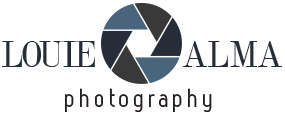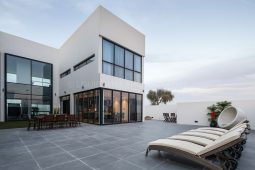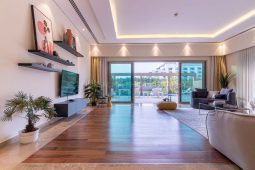The motto of Oliver da Costa’s SEEN rooftop restaurant in Lisbon is “Sin and be Seen”. It has a snappy ring, perhaps even a suggestion of something a little naughty, but the whole SEEN dining experience didn’t feel like sinning at all.
We were on the lofty Tivoli Hotel on Avenida da Liberdade, probably the most glamorous boulevard in Lisbon where space and intimacy have been so gracefully combined that I wasn’t aware that this restaurant has 200 covers.
The environment is an Art Deco-inspired setting, dappled by dimmed lighting, and hemmed by natural verdant flora. We were sitting by long glass windows enjoying spectacular views of the hills of Lisbon. It actually felt glorious, and a little indulgent.
And it’s a tad exclusive. From the Tivoli Hotel lobby, a dedicated lift rises to the 9th floor opening up to a reception area framed by a tree. From there a set of doors open up to reveal a spectacular scene of a square bar the 360º Bar, lit up under the canopy of the lush greenery of a tree reaching up from its centre.
The verdant theme hemmed the entire restaurant to great effect. Further into the restaurant are comfy half-circle green velvet chairs as well as a selection of tables by the window.
Further still is the alfresco Sky Bar, which was unfortunately closed due to bad weather. But the views are spectacular so we made ourselves comfy by a window table to enjoy the scene while we eat and drink.
SEEN offers a fusion of contemporary Mediterranean and Japanese cuisine. Choices like Tacos, Lobster Spaghettini, Laminated Wagyu, and a selection of Sushi and Sashimi, are some of the top choices on the menu signed by Olivier da Costa.
There are a couple of carpaccios – Octobpus and Organic Beetroot. These are sharing plates and as one of us was averse to seafood we opted for the beetroot carpaccios.
Three colours of beetroot, pink, purple and yellow, came sprinkled with feta cheese, dill, capers, orange and lime juice, and caramelised macadamia nuts.
 We enjoyed this with the straw-hued Esporao Reserva Branco, a classic Alentejo white, a creamy yet fruity number. A fabulous pairing by the sommelier.
We enjoyed this with the straw-hued Esporao Reserva Branco, a classic Alentejo white, a creamy yet fruity number. A fabulous pairing by the sommelier.
For the mains we ordered blackened cod with a side of ricoh rice which is a glorious mix of dates and files beans. soya butter. asparagus and almonds. The second dish was Franguinho, a miso-marinated chicken with kimuchi with a side of artichoke au gratin with cornflour milk and cheese sauce and topped with Parmesan.

Franguinho miso marinated chicken with kimuchi
We paired these dishes with two more Portuguese wines: the Tres Bagos Sauvignon Blanc 2023 offering ripe fruit like pineapple and melon and notes of asparagus and the dark red, almost opaque Ravasqueira Desde Vinho Tinto 2023 offering plenty of red and black fruit. Naturally, it all went down very well.
Dessert was a highly indulgent, hefty Banana cake topped with peanut crumble and served with salted caramel icecream.
Verdict: This restaurant is spacious and intimate all at the same time with seating that means everyone has space and privacy. SEEN offers A gorgeous bar that serves any tipple you can think of and a delicious Mediterranean menu If a little indulgence is a sin then I would be happy to “Sin at SEEN” anytime.
Opening hours:
- Sunday to Thursday from 6:30 pm to 01:00 am
- Fridays and Saturdays from 6:30 pm to 02:00 am
Address: Hotel Tivoli Avenida da Liberdade
Avenida da Liberdade, 185, 9º floor
1260-050 Lisboa
More about SEEN RESTAURANT
You may also like:
JNcQUOI restaurant review, Lisbon
Hyatt Regency Lisbon hotel review
Lisbon City Break
The post SEEN rooftop restaurant review, Lisbon, Portugal appeared first on The Travel Magazine.







 We enjoyed this with the straw-hued Esporao Reserva Branco, a classic Alentejo white, a creamy yet fruity number. A fabulous pairing by the sommelier.
We enjoyed this with the straw-hued Esporao Reserva Branco, a classic Alentejo white, a creamy yet fruity number. A fabulous pairing by the sommelier.





